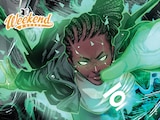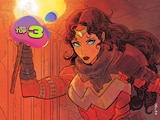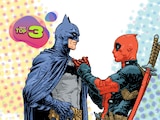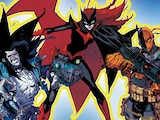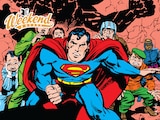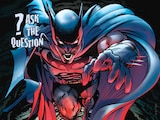Batman: The Long Halloween: The Last Halloween is not a Batman story. Or at least, it’s not just a Batman story. It’s a story about a friendship between a writer and an artist that changed the face of comics across two of its greatest publishers—a commemoration of a partnership that ended far too soon with the passing of a generational talent. With many of the industry’s greatest artists today joining the series to pay reverent tribute to Tim Sale, it’s just as much tribute to “Jeph Loeb and Tim Sale”—a dual creative force that gave us some of the most essential distillations of our greatest heroes.
It’s easy to say that The Last Halloween ends the story that began with Batman: The Long Halloween, the thirteen-month crime epic sweeping through Gotham and Batman’s rogues gallery that has served as an entry point to Batman’s comic universe for over nearly thirty years. But the actual beginning goes back further still. Jeph Loeb and Tim Sale’s story really begins in a series called Batman: Legends of the Dark Knight which ran from 1989 through 2007. It was in this volume that we may find what you could call the First Halloween.
1985’s Crisis on Infinite Earths was designed to be a reset point for the DC Universe—a grand event after which any new reader could check in and enjoy a comic without any of the fifty years of accrued narrative baggage. Many titles were refreshed with brand new series that reset their numbering back at #1—new starting points where you could follow established heroes from new beginnings onward. Batman, however, was not one of them.

Despite an acclaimed four-issue story by Frank Miller and Dave Mazzucchelli within the main Batman title that helped re-establish his origins for the new continuity, Batman: Year One, the main Batman title mainly conducted business as usual, telling new stories in an ongoing, developing narrative for the Bat-faithful. There were new enemies, new romances and even new Robins with revised origins themselves. With a new wave of “Batmania” on the horizon with the impending, hotly anticipated release of Tim Burton’s Batman, there was a pressing need for a title that presented Batman at his most essential. An absolute Batman, if you will, for the time.
It was with this ethos that Legends of the Dark Knight was devised—an ongoing monthly series which would take place not in the modern day of the DC Universe, but one which would take inspiration from Miller and Mazucchelli’s Year One by setting itself in the dawn of Batman’s career. No longer would readers have to puzzle through Pre-Crisis comics and pick through surmounting canonical discrepancies to determine the character’s early nights. Legends of the Dark Knight would present them anew, allowing readers to experience a fresher Batman as they recently had with John Byrne’s Superman and George Perez’s Wonder Woman.
Legends of the Dark Knight would feature rotating creative teams telling landmark stories like Batman: Gothic, setting up much of the early themes of Grant Morrison’s Batman epic to come, and Batman: Venom, introducing the super drug which would eventually define Bane into Batman’s world. (As a quick note, both of these stories were recently highlighted by fellow contributor Jules Chin Greene, in his listing of his five best Batman anthology stories.)

Legends of the Dark Knight was a success. In fact, it proved so popular that twelve issues a year just weren’t enough. In addition to an Annual, a Halloween special was devised to give DC’s most Halloween-ready hero a place to reflect the holiday spirit. Jeph Loeb and Tim Sale, previously collaborators on a cult classic 1991 Challengers of the Unknown reboot, were tapped to devise what Batman’s Halloweens in Gotham City might look like.
Horror being the watch word of the night, Loeb and Sale naturally employed Batman’s most fear-focused villain, the Scarecrow, for the story. The story itself isn’t necessarily one that’s too rife with incident, more or less presenting what you might expect from a Batman and Scarecrow story, with Scarecrow exposing Batman to his greatest fears. But you can clearly see much groundwork for the future being laid here: the evocative angular style, Scarecrow’s taunting sing-song voice, and the willingness to portray the all too often invincible Batman as vulnerable, struggling each night to keep a half-step ahead of his enemies.
Loeb and Sale’s follow-up the next year, Legends of the Dark Knight Halloween Special: Madness, would color the Mad Hatter and a young Barbara Gordon into their developing Gotham City. But it’s their next and final 1995 special, Ghosts, which truly stands out among the three.

If you’ve been in a half dozen conversations about Batman, you’ve probably encountered this question: “If Batman’s so rich, why doesn’t he fight crime by just giving all his money to charity?” It’s a question asked by 2022’s The Batman, and indeed, all the way back in Ghosts by Loeb and Sale. Curiously, this Halloween story set early in Batman’s career takes its inspiration from a Christmas story—specifically, Charles Dickens’ A Christmas Carol. It’s here that Loeb and Sale’s visions of the Penguin, Poison Ivy, and the jagged, disquieting grin of the Joker first materialize, the latter two as spectres of a Gotham City past and present to haunt a bedeviled Bruce Wayne. The night proves so disturbing to his conscience that the next morning, he schedules a meeting with Lucius Fox to establish the Wayne Foundation and puts the lights on in his typically reclusive manor for trick-or-treaters.
All three of these early entries in the Loeb and Sale canon can be found collected as Batman: Haunted Knight. These are the stories, with their radical reshapings of Batman’s costumed coterie of criminals and a rare humanization of Bruce Wayne, which set up The Long Halloween—a name you may now perhaps understand as tribute to their preceding Batman work together. What if Loeb and Sale’s annual Halloween meetings could go on all year long? It’s not just a holiday reference, but an acknowledgement of the series as spinning off from the Halloween specials which brought them to Gotham together.
Sorrowfully, Tim Sale passed away before the duo’s plans for their grand finale, The Last Halloween, could materialize. But in his memory, Loeb has enlisted colleagues, proteges and many whom Sale’s dramatic, evocative work has inspired to finish the story. As we prepare for one last, long Halloween, this is the month to start getting caught up on all that came before. But if you’ve set your sights on the original Long Halloween as your starting point, perhaps consider setting your gaze a little further back.
Batman: Haunted Knight and Batman: The Long Halloween can both be read on DC UNIVERSE INFINITE. Batman: The Long Halloween: The Last Halloween #1 will be available this week in print and as a digital comic book.
Alex Jaffe is the author of our monthly "Ask the Question" column and writes about TV, movies, comics and superhero history for DC.com. Follow him on Bluesky at @AlexJaffe and find him in the DC Official Discord server as HubCityQuestion.
NOTE: The views and opinions expressed in this feature are solely those of Alex Jaffe and do not necessarily reflect those of DC or Warner Bros. Discovery, nor should they be read as confirmation or denial of future DC plans.

